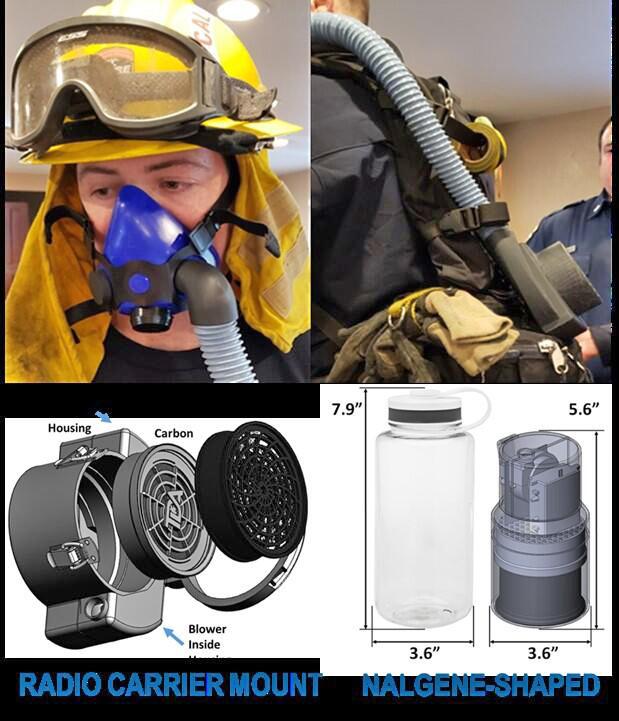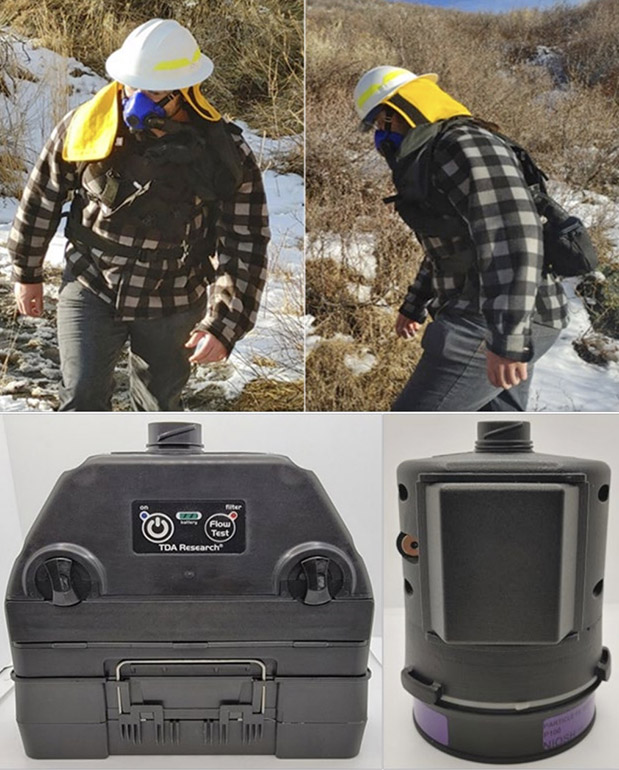
A working group for the International Agency for Research on Cancer, the cancer agency of the World Health Organization, has just “classified occupational exposure as a firefighter as carcinogenic to humans.” Part of the reason is the toxic gasses firefighters are exposed to.
Wildland firefighters working on a vegetation fire can’t wear the conventional self contained breathing apparatus used by structural firefighters. It is too bulky, heavy, and only lasts 10 to 30 minutes.
In an effort to provide less carcinogenic air to wildland firefighters, the Department of Homeland Security’s Science and Technology Directorate is developing a respirator capable of removing airborne hazards present in the wildland firefighting operating environment. They are working with the International Association of Firefighters, National Fire Protection Association, International Association of Fire Chiefs, U.S. Forest Service, and local Colorado fire departments to develop and test the Directorate’s Wildland Firefighter Respirator (WFR). It contains a HEPA filter module that will remove very fine particulates, and a carbon sorbent to remove toxic gases. The team is investigating wildland firefighter-approved designs like the Radio Carrier and Hip-Mounted units shown in the photo below.

The WFR was designed around a lightweight mask covering just the mouth and nose. It relies on filtration, designed to go a whole shift before needing to be changed.
“Our system pushes clean air to firefighters using a powered blower with HEPA and carbon filters,” said S&T Program Manager Kimberli Jones-Holt. The system connects to the half-mask through a lightweight, flexible breathing hose to provide clean air and draws in air from the bottom of the unit to prevent rain or water infiltration.
“The filters were also designed to be inexpensive and easily replaced at $5 to $10 each,” Jones-Holt continued.
It uses an electric blower to force filtered air to the mask, relying on AA batteries for power.
The DHS says if wildland firefighters use respiratory protection, their careers could be significantly extended, leading to a more educated and experienced workforce capable of more efficient operations, with lower medical bills and training costs.
Thanks and a tip of the hat go out to Bob.

J’aimerais proposer une autre technologie de rupture, et de pouvoir l’orienter vers ce type d’usage.
Je vous invite à voir ce lien vers la solution Y-CAT :
ycat.fr
Contactez moi, si vous souhaitez en savoir plus, via LinkedIn, Jean Yves Boulay, Y-CAT
I welcome the respirator conversation. I think we need to review all our gear. We need to remain tactical athletes and not add more bulk, start by shaving ounces off of everything we have.
The devil you know is better than the devil you don’t. Does the Wildland community want this? My department has had full masks with canisters for 15yrs….no one has ever worn one..
although best intentioned, it was proof to hear from firefighters who had hands on it : the device needs technology’s Best efforts to refine it These men and women are ahead of anyone in importance of whom exist in this era of climate change
Wait until you tell ‘em they have to shave their beards
I wonder if there were structural firefighters complaining about how heavy SCBA is when it came out.
Wildfire smoke causes cancers that will KILL you, no matter how tough you are. I notice a huge difference in my ability to work & breathe in heavy smoke while wearing my sundstrom mask. Hopefully this would be even more effective. Better PPE shouldn’t scare us, this is for us to live longer!
A lot of wildland people get worked up any time respirators are discussed, but I think these are badly needed. It’s not like you’ll be wearing them all the time in a fire, assuming you and your overhead have at least half a brain. Hiking? Probably not, unless you are in the back half of a line of 20 people humping up a moon dust dozer line. Prepping road or digging line? Probably not, unless you happen to be wrapping the head of the fire where the smoke is blowing. Holding in the smoke? Yes. Mopping up where you can see particulate floating around your face? Hell yeah. We all talk about how bad the smoke, dust, and particulate is for us, but then most of us scoff at the notion of doing anything to help the issue.
I was involved in testing a Wildland respirator back in the ‘80s, It did not work then as being to bulky and restricted airflow. New technology might help now but I do not think it’s possible to add this to all of the gear now being carried. My two cents.
Robots will be coming soon and they won’t complain.
It’s a great gesture and I appreciate the effort but that thing is just not practical. Try wearing that while humping a 1000+ very on a south slope while in tool order in August. It would be great for holding Rx control lines where the holding resources are stuck on a line sucking *%%*^ against the wind.
I totally agree, but I rarely breathe much smoke while hiking or working hard. I think of it as reduced exposure not risk eliminated. Usually my worst exposures are while holding for burn operations or doing smoky mop up. Wearing one only for those activities would probably reduce more than half of my smoke exposure. Maybe much more than that. And it would be possible to wear a respirator because those activities aren’t very strenuous.
Change is hard but good. There are structure firefighters alive who remember barely using air packs, but they’re universally used today. We all deserve a long retirement!
So don’t wear it on the hike in. You can decide when to put it on. It would be stupid to wear it when you don’t have to or when you’re huffing up a hill; it would be stupid to not wear it when holding a smoked out line or while doing dirty mop up.
During my third and last season on a hotshot crew my lungs were talking to me. So I, of my own initiative, bought what would be considered today a ‘n95’ type face mask to protect my lungs. On the first fire, when I put the thing on, I was written up for ‘safety violation’. “In an emergency, no one could hear you yell for help”. That was my last season.
When our crew returned from the Yellowstone 1988 fires we all went to the hospital for bronchitis. While on line in Yellowstone some researchers joined us for a day with a ‘smoke measuring’ device. They claimed, on what we described as a light to moderate smoke day, that the exposure was the equivalent of smoking two packs of tobacco cigarettes a day.
We took light heart-ed bets towards the end, on who would cough up a lung chunky for the day.
Who was that who wrote you for a “Safety Violation?”
What were their credentials? oh wait, 1988, everyone was an expert on safety and OSHA back then
#DeltaAlphas
I, too, had severe bronchitis by the time I demobed from the Yellowstone fires. It was like pulling teeth even to get the med unit and my crew sup’ to sign off on a CA-2. I’ve been in wildland since and not surprisingly when I when in to have lung capacity testing done a couple years ago, mine came out as operating at only 48%. In retrospect I would have gladly worn the type shown by R3 Engineer above.
I keep a stack of these in the engine and one in a ziploc in my line gear. Easy on/off. Same price each as their replacement filters…
https://www.moldex.com/product/2800-n95-nuisance-organic-vapor-ozone-respirator/
I stick out like a sore thumb on the fire line wearing one, I’m trying to get to enjoy retirement.
Yours looks a lot more practical!
Yea, no thanks! Its just not feasible to wear something like this and continue working in the conditions we have. In R3 when its 115 out and your next to the fireline this isn’t gonna work. Nice thought but not practical in my opinion.
About time we get some PPE for our lungs. This thing sounds over engineered though. I personally already have a mask I wear for burn ops but I’m the only person I ever see wearing one – might get in the way for those that chew
Is it the sundstrom? I’ve been carrying one of those forntgeblast 3 years and it’s now oermeqted the crew to about 75%. It’s changed the game. Don’t wear it every minute of every shift but having access to it for an unfavorable burn op or a nasty inversion before it breaks gives myself and others some semblence of protection.
The idea is great! Unfortunately the design looks pretty impractical. If it’s attached to the back of your web gear how is a hose pack going to also fit. If it’s attached to the chest it’s going to be darn hard to bend over.I can say however, that had something like this been available during my career I wouldn’t be down to one kidney. Don’t give up – keep working on a practical device as it’s sorely needed
Web gear, water, fire shelter, food, radio & batteries, jacket, 1st aid, spare gloves & socks, flagging, file, tool, fuel & oil, headlamp & batteries, space binky, fusees, mountain money…. Hope that thing is light.
But still no H pay because it’s a planned event.
Exactly. I propose we (the actual grunts) stand down on all Rx until we get H pay AND a much larger retirement annuity since Rx severely truncates our retirement…due to death.
No more prescribed fire til I have one of these. Having a planned event to place people in an environment of know carcinogens, with no mitigation whatsoever of said carcinogens is complete bullshit. I’m done killing myself for the agency’s garbage